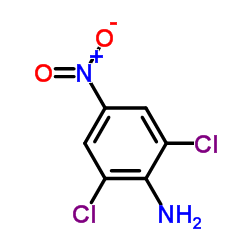2,6-Dichloro-4-nitroaniline

2,6-Dichloro-4-nitroaniline structure
|
Common Name | 2,6-Dichloro-4-nitroaniline | ||
|---|---|---|---|---|
| CAS Number | 99-30-9 | Molecular Weight | 207.014 | |
| Density | 1.6±0.1 g/cm3 | Boiling Point | 323.0±37.0 °C at 760 mmHg | |
| Molecular Formula | C6H4Cl2N2O2 | Melting Point | 187-192 ºC | |
| MSDS | Chinese USA | Flash Point | 149.1±26.5 °C | |
| Symbol |



GHS06, GHS08, GHS09 |
Signal Word | Danger | |
|
Application of the phylogenetic species concept to Wallemia sebi from house dust and indoor air revealed by multi-locus genealogical concordance.
PLoS ONE 10(3) , e0120894, (2015) A worldwide survey of Wallemia occurring in house dust and indoor air was conducted. The isolated strains were identified as W. sebi and W. muriae. Previous studies suggested that the W. sebi phylogenetic clade contained cryptic species but conclusive evidenc... |
|
|
Strontium exerts dual effects on calcium phosphate cement: Accelerating the degradation and enhancing the osteoconductivity both in vitro and in vivo.
J. Biomed. Mater. Res. A 103(5) , 1613-21, (2015) Calcium phosphate cements (CPCs) have long been used as osteoconductive bone substitutes in the treatment of bone defects. However, the degradation rate of CPC is typically too slow to match the new bone growth rate. It is known that strontium increases the s... |
|
|
Characterization and identification of an indirect cytochrome P-450-initiated denitrosation of 2,6-dichloro-4-nitroaniline in rat hepatic microsomes.
Toxicol. Appl. Pharmacol. 95(1) , 139-52, (1988) The metabolism of 2,6-dichloro-4-nitroaniline (DCNA) to a unique denitrosated product, 3,5-dichloro-p-aminophenol (DCAP), was investigated in rat hepatic microsomes using an HPLC system containing a reverse-phase column and an electrochemical detector. The pa... |
|
|
Evaluation of dicloran's contribution to the mutagenic activity of Cristais River, Brazil, water samples.
Environ. Toxicol. Chem. 28(9) , 1881-4, (2009) 2,6-Dichloro-4-nitroaniline (dicloran) is a mutagenic aromatic amine used as an agricultural fungicide and in the synthesis of disperse dyes. It is a known mutagen (Salmonella/microsome assay) in strains TA98 and TA100. Dicloran was initially detected, but no... |
|
|
Acute toxicity of cadmium, copper, zinc, ammonia, 3,3'-dichlorobenzidine, 2,6-dichloro-4-nitroaniline, methylene chloride, and 2,4,6-trichlorophenol to juvenile grass shrimp and killifish.
Bull. Environ. Contam. Toxicol. 44(5) , 776-83, (1990)
|
|
|
Evaluation of modified dichloran 18% glycerol (DG18) agar for enumerating fungi in wheat flour: a collaborative study.
Int. J. Food Microbiol. 29(2-3) , 161-6, (1996) Dichloran 18% glycerol agar base supplemented with 100 micrograms of chloramphenicol ml-1 (DG18 agar) was compared to DG18 agar supplemented with 100 micrograms of Triton X-301 ml-1 (DG18T) and DG18 agar supplemented with 1 microgram of iprodione [3-(3,5-dich... |
|
|
Quality control of Aspergillus flavus and A. parasiticus agar and comparison with dichloran 18% glycerol agar: a collaborative study.
Int. J. Food Microbiol. 89(1) , 99-102, (2003) AFPA culture medium, which is used for recognition of Aspergillus flavus and A. parasiticus, has been validated in a collaborative study including nine laboratories located in Australia, Brazil, Denmark, The Netherlands, Sweden and United Kingdom. Three freez... |
|
|
Relationship between sampling duration and concentration of culturable airborne mould and bacteria on selected culture media.
J. Appl. Microbiol. 102(6) , 1479-84, (2007) This study was designed to evaluate potential effects of sampling duration on observed concentrations of airborne culturable mould and bacteria on selected media.Airborne culturable mould and bacteria from lightly to moderately contaminated environments were ... |
|
|
A multi-lysimeter investigation on the mobility and persistence of pesticides in the loam soil of the Fucino Plain (Italy).
J. Environ. Monit. 10(6) , 747-52, (2008) In order to evaluate the impact of intensive horticulture on the water resources of the Fucino Plain, one of the most important agricultural settlements of Central Italy, the mobility and persistence in the soil of five commonly used pesticides was investigat... |
|
|
Fungicide inhibition of aflatoxins, diacetoxyscirpenol and zearalenone production.
Folia Microbiol. (Praha) 38(4) , 295-8, (1993) The effect of fungicides on the production of aflatoxin by Aspergillus flavus IMI 89717, diacetoxyscirpenol and zearalenone by Fusarium graminearum was studied. In a yeast extract-sucrose medium, dicloran, iprodione and vinclozolin fungicides significantly in... |